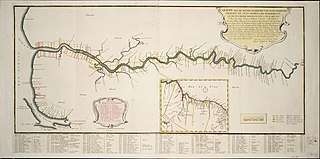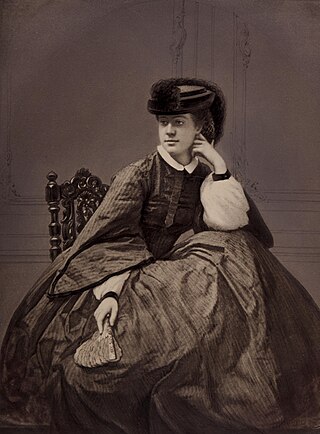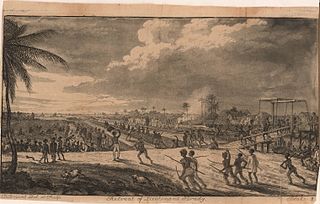Related Research Articles

Triangular trade or triangle trade is a historical term indicating trade among three ports or regions. Triangular trade usually evolves when a region has export commodities that are not required in the region from which its major imports come. Triangular trade thus provides a method for rectifying trade imbalances between the above regions.

Demerara is a historical region in the Guianas, on the north coast of South America, now part of the country of Guyana. It was a colony of the Dutch West India Company between 1745 and 1792 and a colony of the Dutch state from 1792 until 1815. It was merged with Essequibo in 1812 by the British who took control. It formally became a British colony in 1815 until Demerara-Essequibo was merged with Berbice to form the colony of British Guiana in 1831. In 1838, it became a county of British Guiana until 1958. In 1966, British Guiana gained independence as Guyana and in 1970 it became a republic as the Co-operative Republic of Guyana. It was located around the lower course of the Demerara River, and its main settlement was Georgetown.

Alexandrine "Alexine" Pieternella Françoise Tinne was a Dutch explorer in Africa who was the first European woman to attempt to cross the Sahara. She was an early photographer.

Sugar plantations in the Caribbean were a major part of the economy of the islands in the 18th, 19th, and 20th centuries. Most Caribbean islands were covered with sugar cane fields and mills for refining the crop. The main source of labor, until the abolition of chattel slavery, was enslaved Africans. After the abolition of slavery, indentured laborers from India, China, Portugal and other places were brought to the Caribbean to work in the sugar industry. These plantations produced 80 to 90 percent of the sugar consumed in Western Europe, later supplanted by European-grown sugar beet.

Sir John Gladstone, 1st Baronet, was a Scottish merchant, planter and Tory politician best known for being the father of British Prime Minister William Ewart Gladstone. Born in Leith, Midlothian, through his commercial activities he acquired ownership over several slave plantations in the British colonies of Jamaica and Demerara-Essequibo; the Demerara rebellion of 1823, one of the most significant slave rebellions in the British Empire, was started on one of Gladstone's plantations.

The Molasses Act 1733 was an Act of the Parliament of Great Britain that imposed a tax of six pence per gallon on imports of molasses from non-British colonies. Parliament created the act largely at the insistence of large plantation owners in the British West Indies. The Act was passed not to raise revenue but to regulate trade by making British products cheaper than those from the French West Indies. The Act greatly affected the significant colonial molasses trade.
John Abraham Tinne (1877–1933) was a British politician. He was elected as a Conservative Member of Parliament at the 1924 general election, representing Liverpool Wavertree. He resigned in 1931 through appointment as Steward of the Chiltern Hundreds.

The Demerara rebellion of 1823 was an uprising involving between 9,000 and 12,000 enslaved people that took place in the British colony of Demerara-Essequibo in what is now Guyana. The exact number of how many took part in the uprising is a matter of debate. The rebellion, which began on 18 August 1823 and lasted for two days. Their goal was full emancipation. The uprising was triggered by a widespread but mistaken belief that Parliament had passed a law that abolished slavery and that this was being withheld by the colonial rulers. Instigated chiefly by Jack Gladstone, an enslaved man from the "Success" plantation, the rebellion also involved his father, Quamina, and other senior members of their church group. Its English pastor, John Smith, was implicated.
James Blair was an Irish planter and politician. He entered the Parliament of the United Kingdom as a Tory in 1818 to protect the interests of the West Indian planter class. Blair sat in the House of Commons from 1818 to 1830, and later from 1837 to 1841. When slave owners in the British Empire were compensated for the abolition of slavery in Britain's colonies in 1833, Blair received the biggest single compensation payment.
Samuel Sandbach was successively bailiff, coroner and Mayor of Liverpool, as well as High Sheriff of Denbighshire and a Justice of the Peace for Lancashire. He made his fortune as a merchant in a partnership that traded with the West Indies and owned slaves.
Tinne is a Dutch surname. Notable people with this surname include:
Barton, Irlam and Higginson, earlier Barton & Co, was a noted Liverpool firm of shipowners specializing in the trade with Barbados in the first half of the 19th century. The three partners were William Barton, George Irlam, and John Higginson. The firm made a practice of naming several of its vessels after the partners.
Charles McGarel (1788–1876) was an Irish merchant and planter. In 1833, the British Government abolished slavery and compensated owners, such as McGarel, who became a major beneficiaries of this scheme. With his wealth he conducted business in the City of London, funded civic works in his home town of Larne, County Antrim and bought land and property in Ireland. Having no children, he left his estate to his brother-in-law, James Hogg, on condition that he integrate McGarel into his family name, becoming James McGarel-Hogg, later Lord Magheramorne.
John Stewart was a British Conservative and Tory politician and pro-slavery lobbyist. He was possibly the second mixed-race Member of Parliament (MP) of the Parliament of the United Kingdom after James Townsend.
Dorothy Thomas was a Caribbean entrepreneur and former slave who engaged in business in Montserrat, Dominica, Grenada, Barbados, and Demerara. Having purchased her own manumission, Thomas spent nearly sixteen years securing the freedom of her children, mother, and several other relatives. Though she owned hotels one of which had a French restaurant, her primary source of income was hiring out female hucksters to whom she supplied goods to be sold to plantation workers and slaves. She also hired out her slaves as labourers, earned income from lodging houses, ran a plantation, and rented out properties which she owned. Known as one of the few black women who derived compensation from the government scheme to reimburse slave owners, she received £3,413 for the loss of her labourers when Britain abolished slavery.
George Rainy was a Scottish merchant, slave owner and land owner.
William Atherton, was a merchant and wealthy landowner from Lancashire, England, who operated and co-owned sugar plantations in the former Colony of Jamaica. He was a slave owner, as well as an importer of slaves from Africa.
Green Park Estate was one of several sugar plantations owned by William Atherton and his heirs. It was located in Trelawny Parish, south of Falmouth, Jamaica. By the early nineteenth century, at least 533 people were enslaved there producing mainly sugar and rum.
James Fraser younger of Belladrum, also known as James Fraser 8th of Belladrum, was a Scottish slave owner.

Lieutenant-Colonel John Bolton was an English merchant, Volunteer Corps officer and slave trader. During the Napoleonic Wars, he raised an 800-strong battalion of the Liverpool Volunteers regiment to defend against Napoleon's planned invasion of the United Kingdom.
References
Notes
- ↑ The comparative purchasing power of £150,452 in 2015 was £12.9 million. [12]
Citations
- 1 2 3 4 Alston (2015), p. 116
- ↑ Hollett (1999), pp. 36–38
- ↑ Haggerty, Sheryllynne (2012). Merely for Money?: Business Culture in the British Atlantic, 1750-1815. Liverpool University Press. p. 46. ISBN 978-1-78138-891-4.
- ↑ Hollett (1999), pp. 38–40
- 1 2 3 Hollett (1999), p. 40
- ↑ "Samuel Sandbach, Esq., of Woodlands, County of Lancaster". Illustrated London News. 3 May 1851. p. 30.
- ↑ Alston, David. "McBean (Tomatin)" . Retrieved 25 August 2017.
- 1 2 3 4 5 Draper (2014), p. 87
- ↑ Hollett (1999), pp. 41–42
- ↑ Alston (2015), pp. 115, 117
- ↑ Blackburn (2015), p. 50
- ↑ Alston (2015), p. 115
- ↑ "Summary of Individual | Legacies of British Slavery".
- ↑ Blackburn (2015), pp. 50, 58
- ↑ Alston (2015), p. 118
- 1 2 Alston, David. "James McInroy" . Retrieved 25 August 2017.
- 1 2 3 Hollett (1999), p. 42
- ↑ Beesley, Pam. "St Nicholas Church Graveyard Research Project" (PDF). Retrieved 25 August 2017.
- ↑ Alston, David (2016). "Rainy, George (1790–1863), merchant, slave owner, and landowner". Oxford Dictionary of National Biography. Oxford Dictionary of National Biography (online ed.). Oxford University Press. doi:10.1093/ref:odnb/107415 . Retrieved 25 August 2017.(Subscription or UK public library membership required.)
- ↑ "The Tinne family". Walter Art Gallery. Retrieved 25 August 2017.
- ↑ "Notice Is Hereby Given". Gore's Liverpool General Advertiser. 10 July 1834. p. 1.
Bibliography
- Alston, David (2015), "'The habits of these creatures in clinging one to the other': Enslaved Africans, Scots and the Plantations of Guyana", in Devine, Tom M. (ed.), Recovering Scotland's Slavery Past, Edinburgh University Press, ISBN 978-0-74869-809-7
- Blackburn, Robin (2015), "The Scope of Accumulation and the Reach of Moral Perception: Slavery, Market Revolution and Atlantic Capitalism", in Hall, Catherine; Draper, Nicholas; McClelland, Keith (eds.), Emancipation and the Remaking of the British Imperial World (Reprinted ed.), Oxford University Press, ISBN 978-1-52610-301-7
- Draper, Nick (2014), "Helping to make Britain great: the commercial legacies of slave-ownership in Britain", Legacies of British Slave-Ownership: Colonial Slavery and the Formation of Victorian Britain, Cambridge University Press, ISBN 978-1-31606-124-4
- Hollett, Dave (1999), Passage from India to El Dorado: Guyana and the Great Migration, Fairleigh Dickinson University Press, ISBN 978-0-83863-819-4